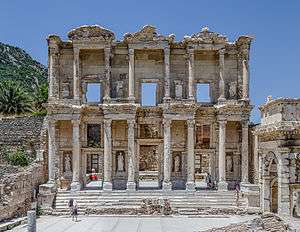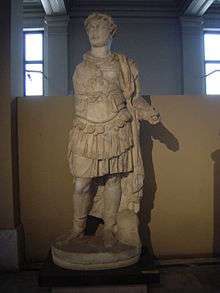Library of Celsus



The Library of Celsus is an ancient Roman building in Ephesus, Anatolia, now part of Selçuk, Turkey. It was built in honour of the Roman Senator Tiberius Julius Celsus Polemaeanus,[2][3] completed between circa 114–117 A.D.[4][5] by Celsus' son, Gaius Julius Aquila (consul, 110 AD). The library was "one of the most impressive buildings in the Roman Empire" and built to store 12,000 scrolls and to serve as a mausoleum for Celsus, who is buried in a crypt beneath the library in a decorated marble sarcophagus.[1][6] The Library of Celsus was the "third-largest library in the ancient world" behind both Alexandria and Pergamum.[7]
The interior of the library was destroyed, supposedly by an earthquake in 262 A.D.,[8] (though other evidence points to a fire during a Gothic invasion in that same year)[6] and the façade by another earthquake in the tenth or eleventh century A.D.[9] It lay in ruins for centuries, until the façade was re-erected (anastylosis) by archaeologists between 1970 and 1978.[10]
History
Celsus, in the honour of whom the library was originally built, had been consul in 92 AD where he was in charge of all public buildings, the Roman proconsul of Ephesus, the capital of the Asian province of Rome from 105–107 AD, and a wealthy and popular local citizen.[6] He was a native of nearby Sardis and amongst the earliest men of purely Greek origin[11] to become a consul in the Roman Empire and is honoured both as a Greek and a Roman on the library itself.[12] Celsus paid for the construction of the library with his own personal wealth.[13] After commissioned by his son in 114 AD,[4][5] construction of the library was completed in circa 117 AD[4][5] in Ephesus, a territory that was traditionally Greek.[14] The building is important as one of the few remaining examples of an ancient Roman-influenced library. It also shows that public libraries were built not only in Rome itself but throughout the Roman Empire.
The interior of the library and all its books were destroyed by fire in the devastating earthquake that struck the city in 262 AD[8] or as multiple other sources report, by fire that same year during a Gothic invasion.[6] Only the façade survived. About 400 AD, the library was transformed into a Nymphaeum. The façade was completely destroyed by a later earthquake, probably in the eleventh or tenth century.[9]
Between 1970 and 1978, a reconstruction campaign was led by the German archaeologist Volker Michael Strocka. Strocka analysed the fragments that had been excavated by Austrian archaeologists between 1903 and 1904.[15] In the meantime, some architectural elements had been acquired by museums in Vienna and Istanbul. In the process of anastylosis, those absent fragments had to be replaced by copies or left missing.[10] Only the façade was rebuilt, the rest of the building remaining in ruin.
Architecture
The library was designed according the principles of the Roman architect Vitruvius. The edifice is a single hall that faces east toward the morning sun, as Vitruvius advised, to benefit early risers. The library is built on a platform with nine steps the full width of the building leading up to three front entrances. The central entrance is larger than the two flanking ones, and all are adorned with windows above. Flanking the entrances are four pairs of Composite columns elevated on pedestals. A set of Corinthian columns stands directly above the first set, adding to the height of the building. The pairs of columns on the second level frame the windows as the columns on the first level frame the doors, and also create niches that house copies of the originals: wisdom (Sophia), knowledge (Episteme), intelligence (Ennoia) and virtue (Arete).[16] It is thought there may have been a third set of columns, but today there are only two registers of columns. This type of façade with inset frames and niches for statues is similar to that found in ancient Greek theatres (the stage building behind the orchestra, or skene) and is thus characterised as "scenographic".
The main entrance is both a crypt containing Celsus's sarcophagus and a sepulchral monument to him.[17] It was unusual to be buried within a library or even within city limits, so this was a special honour for Celsus.
The building's other sides are architecturally irrelevant as the library was flanked by buildings. The interior of the building, not fully restored, was a single rectangular room (measuring 17x11 m) with a central apse framed by a large arch at the far wall. A statue of Celsus or of Athena, goddess of truth, stood in the apse,[18] and Celsus' tomb lay directly below in a vaulted chamber. Along the other three sides were rectangular recesses that held cupboards and shelves for the 12,000 scrolls. Those niches along with the double walls behind them worked to both control the humidity and to protect the scrolls from the extreme temperature.[19] Celsus was said to have left a legacy of 25,000 denarii to pay for the library's reading material.
The second and third levels could be reached via a set of stairs built into the walls to add support to the building and had similar niches for scrolls. The ceiling was flat, and there may have been a central square oculus to provide more light.
The style of the library, with its ornate, balanced, well-planned façade, reflects the Greek influence on Roman architecture. The building materials, brick, concrete, and mortared rubble, signify the new materials that came into use in the Roman Empire around the 2nd century AD.
Commemoration
The building's façade was depicted on the reverse of the Turkish 20 million lira banknote of 2001-2005[20] and of the 20 new lira banknote of 2005-2009.[21]
See also
Footnotes
- 1 2 Hanfmann, George Maxim Anossov (1975). From Croesus to Constantine: the cities of western Asia Minor and their arts in Greek and Roman times. University of Michigan Press. p. 65. ISBN 9780472084203.
...statues (lost except for their bases) were probably of Celsus, consul in A.D. 92, and his son Aquila, consul in A.D. 110. A cuirass statue stood in the central niche of the upper storey. Its identification oscillates between Tiberius Julius Celsus Polemaeanus, who is buried in a sarcophagus under the library, and Tiberius Julius Aquila Polemaeanus, who completed the building for his father
- ↑ Swain, Simon (2002). Dio Chrysostom: Politics, Letters, and Philosophy. Oxford University Press. p. 57. ISBN 9780199255214.
Nevertheless, in 92 the same office went to a Greek, Ti. Julius Celsus Polemaeanus, who belonged to a family of priests of Rome hailing from Sardis; entering the Senate under Vespasian, he was subsequently to be appointed proconsul of Asia under Trajan, possibly in 105/6. Celsus' son, Aquila, was also to be made suffectus in 110, although he is certainly remembered more as the builder of the famous library his father envisioned for Ephesus.
- ↑ Nicols, John (1978). Vespasian and the partes Flavianae, Issues 28-31. Steiner. p. 109. ISBN 9783515023931.
Ti. Julius Celsus Polemaeanus (PIR2 J 260) was a romanised Greek of Ephesus or Sardes who became the first eastern consul.
- 1 2 3 "Ephesus Library". Kusadasi.biz. Retrieved 2 February 2017.
- 1 2 3 Mark Cartwright. "Celsus Library". Ancient.eu. Retrieved 2 February 2017.
- 1 2 3 4 "Celsus Library, Ephesos". Retrieved 2016-10-02.
- ↑ Planet, Lonely. "Library of Celsus - Lonely Planet". Lonely Planet. Retrieved 2016-10-10.
- 1 2 Clyde E. Fant, Mitchell GReddish, A Guide to Biblical Sites in Greece and Turkey, Oxford: Oxford University Press, 2003, p. 194.
- 1 2 Clive Foss, Ephesus After Antiquity: A Late Antique, Byzantine, and Turkish City, Cambridge: Cambridge University Press, 1979, p. 134.
- 1 2 Hartwig Schmidt, 'Reconstruction of Ancient Buildings', in Marta de la Torre (ed.), The Conservation of Archaeological Sites in the Mediterranean Region (Conference, 6–12 May 1995, Getty Conservation Institute), Los Angeles: The Getty Conservation Institute, 1997, pp. 46-7.
- ↑ Richard Wallace, Wynne Williams (1998). The three worlds of Paul of Tarsus. Routledge. p. 106. ISBN 9780415135917.
Apart from the public buildings for which such benefactors paid – the library at Ephesos, for example, recently reconstructed, built by Tiberius Iulius Aquila Polmaeanus in 110-20 in honour of his father Tiberius Iulius Celsus Polemaeanus, one of the earliest men of purely Greek origin to become a Roman consul
- ↑ Werner Eck, Matthäus Heil (2005). Senatores populi Romani: Realität und mediale Präsentation einer Führungsschicht : Kolloquium der Prosopographia Imperii Romani vom 11.-13. Franz Steiner Verlag. p. 267. ISBN 9783515086844.
By contrast, Greek senators were more than free to lavish their wealth on their own cities or other ones... Celsus Polemaeanus of Sardis endows a library at Ephesus in which he is honoured both as a Greek and a Roman; the library itself may have had a similar dual character, recalling the twin libraries of Trajan at Rome.
- ↑ Too, Yun Lee (2010). The idea of the library in the ancient world. Oxford University Press. p. 213. ISBN 9780199577804.
... and son of Julius Celsus Polemaeanus, proconsul of Asia, who founds the Celsian library from his own wealth ...
- ↑ Makowiecka, Elżbieta (1978). The Origin and Evolution of Architectural Form of Roman Library. Wydaw-a UW. p. 62. OCLC 5099783.
It was erected in Ephesus, in Asia Minor, in territory that was traditionally Greek to the core. That is why Celsus' library in Ephesus represents very important element in tracing the development of Roman libraries.
- ↑ F. Hueber, V.M. Strocka, "Die Bibliothek des Celsus. Eine Prachtfassade in Ephesos und das Problem ihrer Wiederaufrichtung", Antike Welt 6 (1975), pp. 3 ss.
- ↑ "Ephesus Library". www.kusadasi.biz. Retrieved 2016-10-10.
- ↑ Makowiecka, Elżbieta (1978). The origin and evolution of architectural form of Roman library. Wydaw-a UW. p. 65. OCLC 5099783.
After all, the library was simultaneously the sepulchral monument of Celsus and the crypt contained his sarcophagus. The very idea of honouring his memory by erecting a public library above his grave need not have been the original conception of Tiberius Iulius Aquila the founder of the library.
- ↑ Ephesus: An OTTI Travel Company. "Celsus Library: Ephesus Turkey." Ephesus.us. 2009. Retrieved March 7, 2010.
- ↑ Ephesus.us. "Celsus Library, Ephesus Turkey". www.ephesus.us. Retrieved 2016-10-10.
- ↑ Central Bank of the Republic of Turkey Archived 2009-06-03 at WebCite. Banknote Museum: 7. Emission Group - Twenty Million Turkish Lira - I. Series Archived 2008-11-22 at the Wayback Machine.. – Retrieved on 20 April 2009.
- ↑ Central Bank of the Republic of Turkey Archived 2009-06-03 at WebCite. Banknote Museum: 8. Emission Group - Twenty New Turkish Lira - I. Series Archived 2009-02-24 at the Wayback Machine..
Announcement on the Withdrawal of E8 New Turkish Lira Banknotes from Circulation Archived 2009-04-22 at the Wayback Machine., 8 May 2007. – Retrieved on 20 April 2009.
References
- Boethius, Axel; J.B. Ward-Perkins (1970). Etruscan and Roman Architecture: The Pelican History of Art. Harmondsworth: Penguin. p. 397. ISBN 978-0-300-05290-9.
- Grant, Michael (1995). Art in the Roman Empire. London: Routledge. pp. 48–50. ISBN 978-0-415-12031-9.
- Robertson, D.S. (1964). Greek and Roman Architecture. London: Cambridge University Press. pp. 289–290. ISBN 978-0-521-09452-8.
- Scarre, Christopher (1995). The Penguin Historical Atlas of Ancient Rome. London: Penguin. p. 76. ISBN 978-0-14-051329-5.
- "Greece and Asia Minor". The Cambridge Ancient History - XI. Cambridge University Press. pp. 618–619, 631. ISBN 978-0-521-26335-1.
- "Library, Rome". The Brill's New Pauly Encyclopedia of the Ancient World, volume 7. Brill Leiden. 2005. p. 502. ISBN 978-90-04-12259-8.
External links
| Wikimedia Commons has media related to Celsus library in Ephesus. |
- classics.uc.edu, Architecture, classical studies, bibliography (Archived)
- Virtual reconstruction of the Celsus library in Ephesus, Turkey
Coordinates: 37°56′20.9″N 27°20′26.7″E / 37.939139°N 27.340750°E